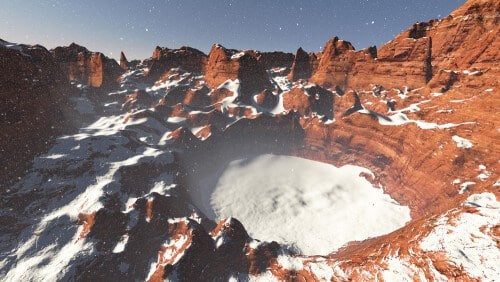On the one hand, there is a great chance of finding life and on the other hand the fear is to eliminate them by bacterial contamination from the earth as happened to the Native Americans following the Spanish conquest. In addition, the water could be used by an expedition that will land on Mars and save the expenses associated with bringing water from Earth

for the discovery of water on Mars It was announced by NASA Yesterday (Monday) there are two separate consequences on the one hand they increase the chance of discovering life in these salty waters, while on the other hand they can help support other life - that of the astronauts who will land there.
At NASA's press conference, Jim Green, director of the Planetary Science Division at NASA, said "under certain circumstances, water has been discovered on Mars."
"Mars is the most tragic planet in the solar system. It used to have a compressed atmosphere, it was covered in water and mud. Just one of its oceans would have covered about two-thirds of the Northern Hemisphere. It has seasons like on Earth, and it could support life as we know it." Author Time weekly website.
The writer of the article in Time defined the situation of Mars as "death in the cradle". "Mars suffered an apocalypse that has never been explained. Perhaps meteorite impacts blasted its atmosphere into space, and the planet's weak gravity caused the remaining air to disappear. The result is the cold, dead, dry planet we see today. And maybe he's not dead."
Will the discovery of water also allow the discovery of living things, even microscopes that use them to survive. Jim Green, Director of the Planetary Science Division at NASA "Under certain circumstances, water has been discovered on Mars." "Discovery of brackish water flowing on Mars does not mean that life is thriving on Mars today or even that it is a reasonable possibility"
The lead author of the Nature Geoscience article, Lujanara Ojah of the Georgia Institute of Technology (GeorgiaTech) in Atlanta, said at a press conference held earlier today at NASA headquarters in Washington that the answer to that is no.
According to him, perchlorate brines have a very low "aqueous activity", which means that the water in them will not be available for potential use by a living being."
If these seasonal channels contain brine saturated with perchlorites, then life as we know it on Earth could survive at such a low level of water activity.

The discovery of the seasonal channels is also significant in terms of the possible use of water by astronauts who will land on Mars. say the researchers. NASA plans to land on Mars by the end of the thirties of the 21st century (that is, in about 25 years) and the presence of liquid, even very salty water on the surface could help in this ambitious endeavor.
The availability of water may reduce the cost and increase the durability of human activity on Mars," Marie Beth Wilhelm, from NASA's Ames Space Center in California, and another co-author of the article (signed by nine researchers), said at the press conference. "Looking ahead, the discovery requires us to deepen our understanding of the source of the water in these channels as well as an assessment of their quantity."
The new discovery supports the idea that NASA has been promoting in recent years - the time has come to commit to sending humans to Mars. The new discovery provides practical reasons - the presence of water on the surface means that the astronauts will have to carry less water with them and it will be much easier for the astronauts in the field to conduct biological experiments during which they will look for the presence of life in this salty water than using remote-controlled machines.
Dr. Simon Foster from Imperial College London He told the "Telegraph".": "The presence of flowing water on the surface of Mars gives us an exciting glimpse into the potential for alien life forms on Mars. "It is possible that there is life there at the level of bacteria and that the robotic landers have collected data that supports the theory that microbes could live on Mars. In the future, if we ever get to Mars, it won't be a short mission like the Apollo missions because of the planet's remoteness. It will be impossible to take all the resources needed by the astronauts and we will have to use what is there, and water is one of the essential factors. As living creatures we need liquid water to survive."
Another aspect that was raised in the questions at the press conference is the fear of the contamination of the ecological niches on Mars with bacteria produced on Earth, whether in a robotic investigation, and especially by astronauts, one of the participants on behalf of NASA answered that already in the current missions, NASA tried as much as possible to sterilize the devices, in any case We will know how to identify bacteria of earthly origin, the chance that the oxidizing bacteria will be similar to them is slim, if only due to the fact that they have undergone a different evolution. As we know, what wiped out the indigenous cultures in Central and South America were the diseases brought by the Spanish from Europe.
to the article on the Time website
to the article in the Telegraph
More of the topic in Hayadan:
- NASA confirms in a press conference: brackish water flows on Mars today
- The MRO spacecraft proved: water flows on Mars today
- Pebbles may indicate that water flowed on Mars in the past
- Water and sulfur and chlorine compounds have been discovered on Mars

7 תגובות
Father, why haven't you been posting blocked comments for two days now?
And why are they even blocked, what's wrong with them? Just annoying.
For environmentalists concerned about the passage of a nuclear reactor in the atmosphere. The reactor, or a final essential part of it, can be assembled in space. A nuclear reactor in a submarine lasts 13 years and is the size of an orange.
One of the many problems that contributes to a long interstellar journey still without gravity propulsion, is a plasma engine.
To produce plasma, which is electrons accelerated to a speed close to the speed of light or positive ions, all that is required is a high voltage of tens of kilovolts. Instead of taking fuel for the entire journey it took, the supply of electrons in the plasma generator is almost infinite. The tremendous speed of the electrons pushed back compensates with momentum for the low mass.
Annie is well aware of whether the space vehicle's speed is limited in this way - but if Philae moves towards Keres for 10 years at a speed of about 30000 km/h, then even a gravitational spaceship, let's say 1,000 times can.
A second way is nuclear propulsion, not with nuclear fuel. As with airplanes, a nuclear reactor produces heat => steam. Where does the water come from, it should be recycled. It is thus possible with a nuclear engine to operate several plasma engines, let's say by generating electricity. Raise low voltage to high voltage, they know how to do that too. Such equipment wears out, and from time to time electronic circuits need to be switched on with new ones. Of course, what I say is at the level of amateurs, but I tried to keep things correct.
What is wrong with my response (and the previous one) that she should wait for the release?
What about the meteorite they found a few years ago and said it probably contained the remains of microscopic worm-like animals? Didn't they say it originated from Mars?
No one will land on Mars in the next fifty years
In order to land on Mars, we must create a spaceship that will run on nuclear power
The technology exists but they are not ready to try and develop it
A nuclear engine would be much smaller, cheaper and they wouldn't need 500 tons of fuel to lift the spacecraft towards Mars